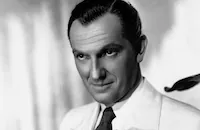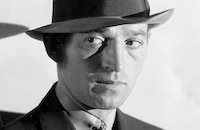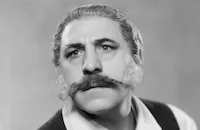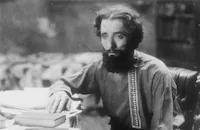Viva Villa

Brief Synopsis
Cast & Crew
Jack Conway
Wallace Beery
Leo Carrillo
Fay Wray
Donald Cook
Stuart Erwin
Film Details
Technical Specs

Synopsis
In the 1880's, after his "peon" father dies from a whipping ordered by a greedy Spanish landowner, Pancho Villa stabs and kills the executioner and then flees into the hills of Chihuahua, Mexico. Many years later, the now grown Pancho enjoys a reputation as "The Cucaracha," a notorious bandit who robs and kills the wealthy and befriends the poor. One day, Pancho's army of avenging bandits is joined by American reporter Johnny Sykes, whom Pancho commandeers to write flattering, exciting reports about the bandits' exploits. As the term of Mexican president Porfirio Diaz reaches its height of bloody injustice, Pancho is called by Don Felipe, an aristocratic revolutionary, to see Francisco Madero, a gentle rebel known as "The Christ-Fool." Moved by Madero's patriotic words, Pancho agrees to help lead a revolutionary army and orders his men to become "soldiers of liberty." After Don Felipe, an aristocratic revolutionary, introduces notorious womanizer Pancho to his beautiful sister Teresa, Pancho rounds up the nation's poor and leads them into many battles. Although successful in combat, Pancho is reprimanded by Madero for killing the wounded enemy and is sent to take orders from General Pascal, who is about to attack government stronghold Santa Rosalia. When, however, Johnny mistakenly reports to his newspaper that the revolutionary army has already taken Santa Rosalia, Villa promises the journalist that his story will not be refuted and refuses to obey Pascal's orders to wait several weeks to attack. Villa's subsequent success at Santa Rosalia and at Juarez eventually leads to the abdication of Diaz and the naming of Madero as president. In spite of his victories, Villa is advised by Madero to return to the country and give up soldiering. Although suspicious of Pascal, who is accompanying Madero to Mexico City, Villa agrees to return to Chihuahua and disbands his army. Later, while Madero struggles to pass land reform legislation, Villa is arrested after his murderous henchman, Sierra, kills a bank clerk who had refused to give Pancho his savings after closing time. The day before Pancho is to be executed for the crime, Pascal, who is overseeing the killing, receives a telegram from Madero, which stipulates that Pancho is to be exiled. Crushed by the apparent betrayal of his beloved Madero, Pancho goes to El Paso, Texas, and becomes a drunk. In Mexico City, before his land reform measure is passed, Madero is assassinated by Pascal and his co-conspirators. Johnny eventually tracks Pancho to El Paso and inspires him to return to Mexico and oust Pascal. Although Pancho leads his "peon" army to a new series of victories, his brutal combat tactics outrage Don Felipe and Teresa. Desperate to possess Teresa, Pancho tries to force himself on her, and when she resists his advances, Sierra shoots and kills her. Later, following a long siege of Pascal's fortress, Pancho overthrows his enemy and condemns him to a slow, torturous death. As the new leader of Mexico, Pancho is overwhelmed with mounting economic problems and, once Madero's land reform is instituted, gladly relinquishes his authority. Back in Chihuahua, as he chats with Johnny outside a butcher shop, Pancho is shot to death by the revenge-crazy Don Felipe.

Cast

Wallace Beery

Leo Carrillo

Fay Wray

Donald Cook

Stuart Erwin

Henry B. Walthall

Joseph Schildkraut

Katherine De Mille

George E. Stone
Phillip Cooper
David Durand

Frank Puglia
Francis X. Bushman Jr.
Adrian Rosley

Henry Armetta
Pedro Regas
George Regas
John Merkyl
Charles Stevens
Steve Clemento
Carlos De Valdez

Harry Cording
Sam Godfrey

Nigel De Brulier
Charles Requa
Tom Ricketts
Clarence Hummel Wilson
James Martin
Anita Gordiana
Francis Mcdonald
Harry Semels
Julian Rivero
Bob Mckenzie
Dan Dix
Paul Stanton

Mischa Auer
Belle Mitchell
John Davidson

Brandon Hurst

Leonard Mudie
Herbert Prior
Emil Chautard
Hector Sarno
Ralph Bushman

Arthur Treacher
William Von Brincken
Andre Cheron
Michael Visaroff
Shirley Chambers
Arthur Thalasso
Chris Pin Martin
Nick De Ruiz
Crew
Juan Aguilar
Wayne Allen
James Brock
Charles G. Clarke
Clyde De Vinna
Howard Dietz
Red Golden
Ben Hecht
James Wong Howe
Robert J. Kern
Stan Lambert
Paul Marquardt
Charles Maxwell
James K. Mcguinness
Mike Mclaughlin
Carlos Navarro
Harry Oliver
Maurice De Packh
Howard Emmett Rogers
Arthur Rosson
Arthur Rosson
Dick Rosson
Matias Santoyo
Matias Santoyo
David O. Selznick
Douglas Shearer
David Snell
Herbert Stothart
Dolly Tree
Slavko Vorkapich
John Waters
William Wellman
Edwin B. Willis

Photo Collections
Videos
Movie Clip





Trailer
Film Details
Technical Specs

Award Wins
Best Assistant Director
Award Nominations
Best Picture
Best Sound
Best Writing, Screenplay
Articles
Viva Villa!
Historical accuracy was seldom a priority with this type of film, but producer David O. Selznick (who called Viva Villa! one of his favorite pictures) tried to balance out the theatrics with at least partial authenticity. The movie was shot mostly in Mexico, adding thousands of dollars to its budget. Some alterations to the original screenplay were also made after it was negatively assessed by both the Mexican government and Villa's widow. Still, Wallace Beery's performance as Villa is so extravagant, it nearly overwhelms any sense of reality.
Screenwriter Ben Hecht attempts to lay some emotional groundwork for Villa's future rampaging: when young Pancho (Phillip Cooper) sees his father whipped to death by a soldier, the boy kills the officer, grows up to become Wallace Beery, and rounds up a group of bandits who pillage the Mexican countryside, robbing from the rich and giving to the poor. Along the way, Pancho encounters Johnny Sykes (Stuart Erwin), an American newspaper reporter who helps spread the bandit's legend in print.
On his crime spree, Villa meets a wealthy landowner (Donald Cook) and his beautiful sister (Fay Wray), who approve of their charismatic friend's Robin Hood philosophy. Through them, Villa joins forces with Madero (Henry B. Walthall), the scholarly leader of the quickly escalating peasant revolt. Pancho's unbridled enthusiasm gets the best of him, however, when he starts robbing banks and shooting innocent people. Soon, he's out of control, making enemies and then corpses of the very folks who originally supported him. Sykes, of course, prints the Villa myth, rather than the reality, every step of the way.
Major hit or not, Viva Villa!'s troubled production was a studio-era predecessor to what Francis Ford Coppola and his crew endured while filming Apocalypse Now (1979). If anything could go wrong, it did, up to and including the loss of both the original director and one of the lead actors. Louis B. Mayer even got punched in the mouth at one point.
Howard Hawks was Viva Villa!'s first director, and he did a lot more than make a few casting decisions. To this day, it's unclear how much of the finished picture is his, but Hawks understood the theoretical prestige of working for MGM, not that it suited his personality. In later years he wrote, "Metro was the best place in the world for getting a script and handing it to a director with it all cast and the sets all built - they had the best set designers, and they had good writers - but I don't think an independent worked well over there."
During the location shoot, real soldiers and peasants were used as extras, and some of them were quite a bit wilder than MGM expected. Hawks claimed that he was once interrupted by a man who poked a rifle in his ribs and, in Spanish, shouted "this is for the revolution." The director decked him without shouting anything at all.
Shootings often took place near the set, and one man inexplicably turned a pistol on himself after speeding by and crashing his car through a fence. MGM's crew was housed in old railroad cars, and they were regularly served nearly inedible food (Hawks said he survived mostly on brandy and oranges). As a special bonus, the film became the subject of angry debate among Mexican citizens and government leaders who were leery of romanticizing Villa. Several reels of footage were also destroyed when a plane that was carrying them crashed on the way to California.
But that, believe it or not, isn't the worst of it. Lee Tracy was known as one of the more enthusiastic drinkers in the film industry; his name was often mentioned in the same breath as such famous imbibers as John Barrymore and W.C. Fields. Tracy's fast-talking persona was perfect for the character Johnny Sykes, and he filmed several key scenes with Hawks behind the camera. One Sunday, during a national holiday, the cast and crew were celebrating in the streets with the locals...except for Tracy, who was standing buck-naked on a balcony, shouting obscenities at the crowd. Eventually, he urinated on a group of Mexican military cadets and had to be rushed out of the country lest he be strung up for his anti-social behavior.
This all led to the firing of Tracy, as well as Selznick having to send a letter of apology to the Mexican government. The firing, in turn, led to an argument between Mayer and Hawks, who wanted Tracy to stay on the picture regardless of the actor's bad reputation. Hawks belted Mayer, another pink slip was written up, and much of the picture had to be re-shot with Conway directing. Ah, the glamour of Hollywood!
Producer: David O. Selznick
Director: Jack Conway, Howard Hawks (uncredited)
Screenplay: Ben Hecht
Cinematography: James Wong Howe
Editing: Robert J. Kern
Music: Herbert Stothart Art Design: Harry Oliver
Set Design: Edwin B. Willis
Costumes: Dolly Tree
Principal Cast: Wallace Beery (Pancho Villa), Fay Wray (Teresa), Stuart Irwin (Johnny Sykes), Donald Cook (Don Felipe), George E. Stone (Chavito), Leo Carrillo (Sierra), Henry B. Walthall (Madero).
BW-111m.
by Paul Tatara

Viva Villa!
Fay Wray (1907-2004)
She was born Vina Fay Wray, in Cardston, Alberta, Canada on September 15, 1907. Her family relocated to Arizona when she was still a toddler so her father could find employment. When her parents divorced, her mother sent her to Hollywood when Fay's eldest sister died in the influenza epidemic of 1918. The reasoning was that Southern California offered a healthier climate for the young, frail Wray.
She attended Hollywood High School, where she took some classes in drama. After she graduated, she applied to the Hal Roach studio and was given a six-month contract where she appeared in two-reel Westerns (25 minutes in length), and played opposite Stan Laurel in his pre-Oliver Hardy days.
She landed her first big role, as Mitzi Schrammell, in Erich von Stroheim's beautifully mounted silent The Wedding March (1928). It made Wray a star. She then starred in some excellent films: The Four Feathers (1929), the early Gary Cooper Western The Texan (1930), and one of Ronald Coleman's first starring roles The Unholy Garden (1931), all of which were big hits of the day.
For whatever reason, Wray soon found herself in a string of thrillers that made her one of the great screamers in Hollywood history. The titles say it all: Doctor X, The Most Dangerous Game (both 1932), Mystery of the Wax Museum, The Vampire Bat (both 1933) and, of course her most famous role, that of Ann Darrow, who tempts cinema's most famous ape in the unforgettable King Kong (also 1933).
Wray did prove herself quite capable in genre outside of the horror game, the best of which were Shanghai Madness with Spencer Tracy; The Bowery (both 1933), a tough pre-Hays Code drama opposite George Raft; and the brutal Viva Villa (1934), with Wallace Beery about the famed Mexican bandit. Yet curiously, the quality of her scripts began to tank, and she eventually found herself acting in such mediocre fare as Come Out of the Pantry (1935), and They Met in a Taxi (1936).
With her roles becoming increasingly routine, the last of which was the forgettable comedy Not a Ladies Man (1942), she decided to trade acting for domesticity and married Robert Riskin, who won two Best Screenplay Oscars® for the Frank Capra comedies It Happened One Night (1934) and Mr. Deeds Goes to Town (1936). When Riskin died in 1955, Wray found herself working to keep busy and support her three children. She landed supporting parts for films like The Cobweb (1955), Hell on Frisco Bay (1956) and Tammy and the Bachelor (1957). She also found work in television on such popular programs as Perry Mason and Wagon Train before she retired from acting all together in the mid-'60s.
To her credit, Wray did remain reasonably active after her retirement. She published her autobiography, On The Other Hand in 1989 and was attending many film festivals that honored her contribution to film, most notably in January 2003, when, at 95 years of age, she accepted in person her "Legend in Film" Award at the Palm Beach International Film Festival. Wray is survived by a son, Robert Riskin Jr.; two daughters, Susan and Victoria; and two grandchildren.
by Michael T. Toole
Fay Wray (1907-2004)
Quotes
Trivia
On 19 November 1933, during location filming in Mexico, Lee Tracy, originally cast as Johnny Sykes, urinated from his hotel balcony onto a military parade, was arrested, fired from the film, and replaced by Stuart Erwin. Original director Howard Hawks was also fired for refusing to testify against Tracy, and replaced by Jack Conway (I).
Much of the footage originally shot by Howard Hawks is said to have been lost in a plane crash. However, Hawks claimed that most of the location footage (except battle scenes) was his.
Notes
In an onscreen foreword, the producers describe this film as "fiction woven out of truth." According to biographical sources, sixteen-year-old Doroteo Arango killed a man for molesting his younger sister and took refuge in the mountains, eventually changing his name to Francisco "Pancho" Villa. In 1910, while he was working as a bandit and part-time laborer, Villa was persuaded to participate in the Madero revolution against President Porfirio Diaz. After Madero became president, Villa, still a member of the irregular army, was condemned to death for insubordination by General Victoriano Huerta. Although the execution was stayed by Madero, Villa remained in prison until escaping to the United States in November 1912. After Madero was assassinated, Villa returned to Mexico and joined forces with Venustiano Carranza to defeat Huerta. Mutual distrust divided Villa and Carranza, who took over as president in 1914, and the civil war continued until late 1915. In early 1916, as a show of power, Villa executed sixteen U.S. citizens in Santa Isabel in northern Mexico and attacked Columbus, NM. Woodrow Wilson then ordered General John J. Pershing to lead an expedition into Mexico to capture Villa, but Pershing's efforts were unsuccessful. By 1920, after years of continued armed insurgency, Villa agreed to "retire" from politics and was given a ranch in Durango. Villa was assassinated on July 20, 1923 in Parral, Chihuahua. The Hollywood Reporter review notes that the character of General Pascal was "more than a little suggestive" of Huerta.
Contemporary news items and studio memoranda, some of them unidentified, note the following information about the production: A May 1933 Hollywood Reporter news item announced that Wallace Smith was returning from Mexico after receiving approval from the government there to proceed with a script for Viva Villa written by Oliver H. P. Garrett. It is not known if any portion of Garrett's script was used in the final film. Jack Conway was announced as director at that time, and John W. Considine, Jr. as supervisor. Considine's participation in the production is doubtful. According to a September 6, 1933 memorandum from producer David Selznick to studio head Louis B. Mayer, Selznick paid writer Ben Hecht $10,000 to write a final script of Viva Villa. Selznick offered Hecht an additional $5,000 if he finished the script to the producer's satisfaction in two weeks. It has not been determined if Hecht met Selznick's deadline, but by the middle of September 1933, director Howard Hawks, a frequent collaborator with Hecht who is credited in modern sources as a contributor to the script, was already in Mexico City shooting preliminary scenes. Hawks and his crew were soon joined by Wallace Beery and other members of the cast. A October 27, 1933 Daily Variety news item announced that scenes were to be shot in "many towns in Mexico." After first rejecting the part, Lee Tracy agreed to play the role of Johnny Sykes in early November 1933 and went to Mexico for filming. According to Variety, the role was based on John W. Roberts, a correspondent for the Hearst newspapers, who followed Villa around Mexico and reported on his exploits. By the end of the month, Tracy was fired from the production because of an alleged insult he made to a cadet in the Mexican Cadet Corps while standing on a hotel balcony during a Revolution Day parade. Contemporary sources do not specify the exact nature of the insult, and modern sources give conflicting reports of the incident. In addition to his firing, Tracy had his five-year contract at M-G-M terminated. M-G-M then replaced Hawks with Jack Conway, who supposedly had been the studio's first choice as director. Studio press releases assert that the replacement was made at Hawks's own request. (Modern sources note that, according to M-G-M contract writer John Mahin, Hawks was fired because of Mayer's dissatisfaction with Hawks's shooting pace. Modern sources claim that Hawks and Mayer fought physically over the matter.)
Because of tensions between M-G-M and the Mexican government over the Tracy incident, the production left Mexico in late November 1933 and, except for second unit shooting, completed filming around Hollywood and at the studio. Some of Hawks's footage was destroyed when an airplane carrying the negatives from Mexico to El Paso, TX, crashed and caught fire. It is not known how much of Hawks's footage actually ended up in the finished film. Although Tracy claimed that reports of his behavior were greatly exaggerated, Mayer issued a formal apology to Mexican president Abelardo Rodríguez. The incident supposedly provoked attacks against American films in the Mexican press, which demanded that the second-unit company also be expelled from the country, and that all M-G-M films be banned from exhibition in Mexico. A November 20, 1933 Daily Variety news item reported that two Mexican newspapers were campaigning for the confiscation of all footage shot in that country and for the cancellation of the studio's permit to shoot there because they believed that M-G-M was guilty of bribery, "malnutrition of extras and degradation of Mexican characters." The Mexican press also complained about the casting of Beery, a comedian, in the title role and condemned the way in which Mexican history was being presented by American filmmakers. According to a February 22, 1934 Daily Variety news item, M-G-M executive Joseph M. Schenck went to Mexico City on a "secret" trip to confer with President Rodríguez about the revised script. When Schenck screened the film for Mexican government officials in late February 1934, only two scenes were found objectionable. The officials complained that the scene in which Villa makes his first entrance into Mexico City needed more soldiers and arranged for the sequence to be re-shot with the entire Mexican army. They also disapproved of a scene in which Beery drinks after a victory. According to the officials, Villa neither drank nor smoked. This scene was not eliminated from the final film, however. (According to a 1951 Time article, the then Mexican government censor objected to the scenes in which Villa disobeys General Pascal and raids Santa Rosalia to please the American reporter and banned the film's revival in Mexico.)
Second unit location shooting was completed in Mexico City and Juarez in mid-December 1933, and approximately seventy-two reels of battle footage were shipped to M-G-M at that time. William Wellman took over directing for one week after Conway came down with the flu in late December 1933. Hecht was called in to write new sequences in mid-February 1934. In late Feb, before re-shooting began, Selznick also assigned Howard Emmett Rogers and James K. McGuinness to do additional script work. The exact nature of their contribution is not known. Retakes were shot in either late February or March 1934. A March 9, 1934 Daily Variety news item announced that M-G-M was sending cinematographer Clyde De Vinna to Mexico to shoot added background shots. According to advertisements for the film, Carlos Navarro, who is credited in the film as technical advisor, was "Mexico's Official Censor for pictures regarding Mexican themes" and acted as a liaison between the studio and the Mexican government. In that advertisement, Herbert Stothart thanks George Schneider for his help on the production. The exact nature of his contribution is not known. The same advertisement credits Slavko Vorkapich with the montage of "Villa's call to arms" sequence. A December 1933 Hollywood Reporter news item announced that the editor was to handle the "direction of transitional effects." In addition to Tracy, who was replaced by Stuart Erwin, all the principal actors in Hawks's cast except Joseph Schildkraut and Beery were replaced, including Mona Maris, Donald Reed and Irving Pichel. After Maris' departure, several actresses, including Myrna Loy, Carmel Myers, Lila Lee and Dorothy Burgess, were tested for the role of Teresa. Before signing Erwin, M-G-M considered Roscoe Karns as a replacement for Tracy. Donald Cook replaced Donald Reed in the role of Don Felipe, and Leo Carrillo replaced Irving Pichel in part of Sierra. In early December 1933, Richard Bennett was tested for the role of Madero but lost the part to Henry B. Walthall. Prior to production, M-G-M negotiated with Gregory Ratoff for a part in the film, but the actor was not hired. Pancho Augustin Villa, Jr., the son of Pancho Villa, was announced in late September 1933 to play his father as a youth in the film. That part was played by Phillip Cooper, however. Early Hollywood Reporter production charts include Pancho Lucas, Noah Beery, Jr. (Wallace Beery's nephew) and Raymond Borzage in the cast. It is not known if they were replaced, or if they appear in the final film. Later Hollywood Reporter production charts include Leo White in the cast, but his participation in the final film has not been determined. A September 1933 Hollywood Reporter news item announced that Selznick was bringing actor Joseph Schildkraut back to the screen after a two-year absence.
Top tickets for the New York showing cost $2.20. Assistant director John Waters won an Academy Award for his work on the production. The film was nominated as Best Picture but lost to Columbia's It Happened One Night. Ben Hecht was nominated for an Academy Award for his adaptation, but lost to Robert Riskin, who adapted It Happened One Night. Douglas Shearer was nominated for Best Sound Recording, but lost to Paul Neal and One Night of Love. Viva Villa was selected as one of the ten best pictures of 1934 by the Film Daily Poll of Critics. On March 8, 1934, a scene from the film script was performed on the NBC radio network. Al Jolson portrayed Johnny Sykes in the radio broadcast, which was repeated on 5 April 1934.
Other films dealing with the life of Pancho Villa include a 1914 Mutual documentary, The Life of General Villa, directed by Christy Cabanne, and the 1916 Tropical Film documentary, Following the Flag in Mexico (see AFI Catalog of Feature Films, 1911-20; F1.1405 and F1.2468); two 1954 Mexican-made features, El secreto de Pancho Villa and La tesoro de Pancho Villa, both directed by Rafael Baledón; and Villa, a 1958 Fox production, directed by James B. Clark and starring Brian Keith and Cesar Romero.

















